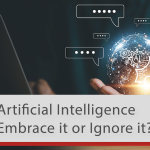
Artificial Intelligence (AI): Embrace It or Ignore It?
September 6, 2023
Politics in the Workplace
September 28, 2023When we talk about Artificial Intelligence (AI) today, many might instantly think of the latest chatbots. But did you know that the concept and practice of AI have been around for much longer than recent innovations like ChatGPT?
A Historical Review
The development of artificial intelligence began in earnest in the 1940s, concurrent with the dawning age of computer technology. Remarkably, the first scientific paper on neural networks—which serves as the foundation for today’s AI—was presented in 1943. Many consider this the true inception of artificial intelligence as a field.
From these early roots, generations of AI scientists dedicated their lives to the discipline. These researchers, spanning eight decades, were born, educated and worked tirelessly in their pursuit of knowledge and innovation. Unfortunately, many of them never witnessed the revolutionary breakthroughs and widespread applications we see today. They paved the way for the advancements we often take for granted, and they are nothing short of legendary in their contributions.
The idea of artificial beings has been a part of human storytelling for centuries. From the myths of automatons like the ancient Greek’s Talos to Mary Shelley’s “Frankenstein,” we’ve long been fascinated by the idea of creating life or intelligence.
Alan Turing, a mathematician and logician, is often considered the father of computer science and artificial intelligence. In the 1950s, he proposed the Turing Test, a method to determine if a machine can exhibit human-like intelligence.
The term “Artificial Intelligence” itself was coined in 1956 during a summer workshop at Dartmouth College, marking the official birth of AI as a discipline.
Early AI Applications
Believe it or not, we’ve had AI-driven solutions for decades:
- Eliza (1960s): Developed at MIT, this early chatbot simulated conversation by pattern-matching and substitution methodology.
- Shakey the Robot (1960s-70s): Developed by the Stanford Research Institute, it was one of the first robots to combine reasoning with physical actions.
- MYCIN (1970s): An early expert system used for decision-making in medical diagnosis, showcasing AI’s potential in healthcare.
AI in Popular Media
Movies and TV have been showcasing AI long before modern advancements. Think HAL 9000 from “2001: A Space Odyssey” or Data from “Star Trek.” While some representations were more fiction than fact, they underscored our interest in and early understanding of AI concepts.
Advent of Neural Networks
In the 1980s and 90s, we witnessed the rise of neural networks and deep learning. These systems, modeled after the human brain, were designed to recognize patterns and learn from data, leading to the early versions of speech recognition and computer vision applications.
Before ChatGPT: Other Notable Innovations
- IBM’s Deep Blue (1990s): Famous for defeating world chess champion Garry Kasparov, showing that machines could outthink humans in specific tasks.
- Apple’s Siri (2010s): One of the first mainstream voice-activated assistants, showcasing practical AI in millions of pockets.
- IBM’s Watson (2010s): Triumphed in the quiz show “Jeopardy!” and has since been applied to areas from healthcare to finance.
So, Why the Recent Hype?
While AI is not new, several factors have propelled its recent explosion:
Data Boom: The digital age produces vast amounts of data daily, the fuel for AI.
Computational Power: Modern computers can process information faster, allowing more complex AI models.
Innovation and Investment: As tech giants invest in artificial intelligence, we’re seeing rapid advancements and applications.
AI has been silently integrated into our lives in subtle ways over the last several years. My bet is that you no longer think of the things I am about to list as being transformative technology.
Email Filters: The Spam filter in your email uses AI algorithms to learn which emails you are likely to read and which ones you are likely to ignore or flag as spam.
Recommendation Engines: You know how Netflix suggests shows or how Amazon recommends products? You guessed it, these platforms use AI to analyze your behavior and preferences to curate content and product suggestions that are tailored for you.
Credit Fraud Detection: Banks use AI-driven algorithms to detect suspicious activities on your account.
Voice-activated Assistants: Siri, Alexa and Google Assistant are now household names!
Photo Tagging Features: Platforms like Facebook utilize auto-tagging of friends in images. How do they do that? AI driven facial recognition.
Does knowing a bit more about the history of AI make you more comfortable in considering implementation?
Navigating the expansive world of AI can seem overwhelming, but remember, every innovation and transformation starts with a single step. If you’re ready to embrace the future and integrate AI into your business operations, I’m here to guide you. With expertise, experience, and a passion for bridging businesses with technology, I can be your compass in this journey.
Don’t venture into the AI landscape alone; let’s collaborate and unlock your business’s full potential. Reach out today, and together, we’ll shape a smarter tomorrow for your enterprise.


